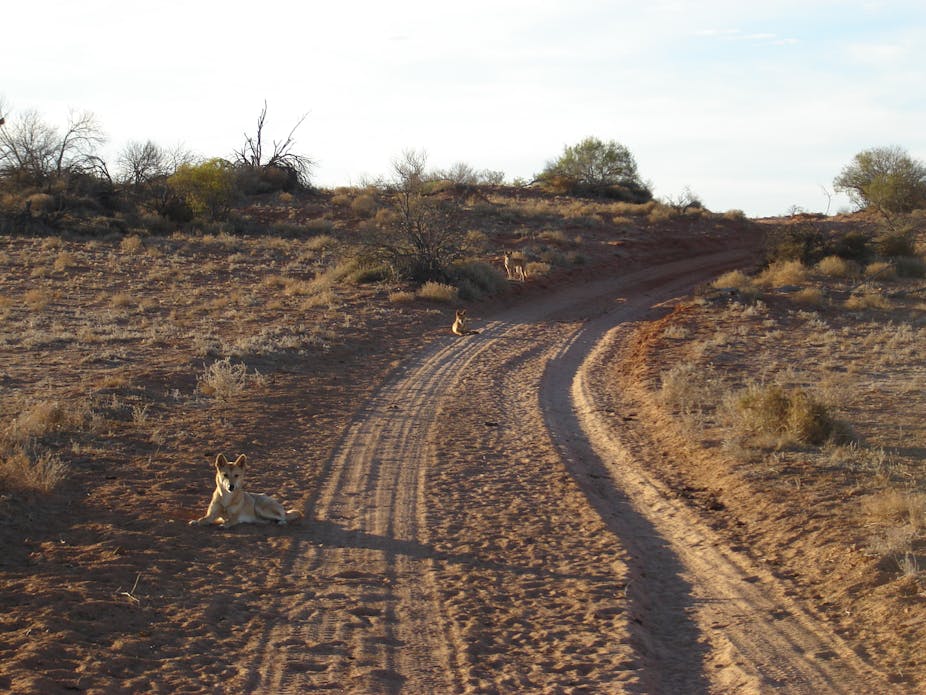Does dingo control harm Australia’s environment? Results from the largest Australian experiment on dingoes – published this week in Frontiers in Zoology – shows the answer to that question is a convincing “no”.
The study showed dingo control programs aimed at protecting cattle in the rangelands — the dry grasslands and woodlands of inland Australia — have little negative effect on wildlife, if any effect at all.
But you might have been led to believe differently — that poison baiting programs intended for dingoes indirectly harm native wildlife populations.
This is a myth, and the reason why is actually quite simple.
The dingo debate
That question hinges on an ecological concept called “mesopredator release”. This hypothesis predicts that a healthy dingo population keeps the ecosystem in balance. Dingoes help control the numbers of medium-sized predators, which in Australia are mostly introduced species such as feral cats and foxed.
Because these predators eat smaller native wildlife, if there are fewer predators, there should be more wildlife.

According to the theory, if you remove dingoes, there will be more foxes and cats, leading to a “trophic cascade” (an ecological chain reaction) of impacts that might result in fewer native animals. If correct, this hypothesis would suggest that we should be concerned about practises that reduce or remove dingoes.
But there is a chronic absence of reliable evidence supporting this hypothesis for dingoes, and there is not a single study measuring a) an increase in medium-sized predators or b) a change in vegetation in response to measured changes in dingoes.
In contrast, there is a growing body of evidence that these processes are absent, as shown by large-scale manipulative experiments conducted in the Northern Territory, New South Wales, and now Queensland and South Australia. Baiting dingoes does not result in wildlife declines.
Australia’s largest predator experiment
Our new research comes from the Australia’s largest predator manipulation experiment (and the second largest in the world behind a study in Canada on wolves). Since the 1990s we’ve been conducting these experiments from the Gulf of Carpentaria to the arid zone of South Australia, and now the results are in.
Several papers have already come out of this series of experiments, including those discussing the effects of baiting on dingo movements, interactions between dingoes and cats, historical case studies of mesopredator releases, and earlier reports on the response of predators to dingo control. More can be found through a simple internet search and more are on the way.
In our latest report, we repeatedly monitored predator and wildlife populations in baited areas next to unbaited areas, before and after baiting, at nine sites across Australia over many years. We found that native wildlife populations living in areas regularly exposed to dingo control do just as well, if not better than nearby areas where dingoes are left untouched.

But why? Well, we found that current dingo baiting practises don’t actually remove or reduce dingo populations enough for foxes and feral cats to increase, hence the chain reaction doesn’t even get started and wildlife are none the wiser.
Ultimately, dingo control programs in these systems are somewhat of an ecological non-event for wildlife, feral predators, and even for dingoes.
Different experiments, different stories
Because we used manipulative experiments to investigate this issue, our results represent the most conclusive work on this topic conducted in Australia.
Experimental research of this kind trumps anything to the contrary that comes from the small-scale, short-term, observational or desktop studies that characterise prior research.
Almost all previous studies investigate this issue with snap-shot or correlative approaches. These are the sort of studies where predators and wildlife are monitored at a given site for only a few days at the most. It’s like taking a photo of a landscape at sunset, and then claiming that the conditions you see in the photo is what the landscape looks like all the time.
Those interested in the different study designs used to study this issue can compare the strengths and weaknesses of each in literature reviews published here or here.
Of course, ecologists have argued, still argue and will undoubtedly continue to argue about the merits of any particular study. But the inability of snap-shot, correlative or observational study designs for determining causation — such as reduced dingoes causing reduced native wildlife — is indisputable.
Only manipulative experiments can determine cause, such as those we describe, and no such manipulative experiments have ever revealed evidence for the dingo control-induced wildlife declines.
What does this mean for dingoes?
Our results have important implications for people managing dingoes and wildlife in the Australian rangelands.
People struggling to conserve native or endangered fauna need not worry that distributing poison-baits to protect cattle from dingoes will have ecological side-effects that compromise native fauna conservation programs. Dingo control can be compatible with biodiversity conservation.
But before people get too carried away thinking that they can distribute poison baits without consequence, we should also recognise that baiting dingoes isn’t permanently reducing dingo populations either. So why still do it?
Baiting programs can certainly provide short-term benefits to cattle producers at times, but robust measures of baiting efficacy require more than simply counting bodies, baits or participants. There needs to be a greater focus on managing dingo impacts, because efforts to “reduce or remove dingoes” clearly aren’t working and can sometimes make the situation worse.
Dingo management strategies should be flexible and responsive to local needs given the positive, negative, neutral and variable effects that dingoes can have on economic, environmental and social assets and values.
The results of our experiments are reassuring, but come with one very important and intuitive proviso:
Control programs that sustainably remove enough dingoes might have an ecological impact, and harm native wildlife.
Thankfully, this is unlikely to ever happen under the current dingo management approaches used across most of Australia.


